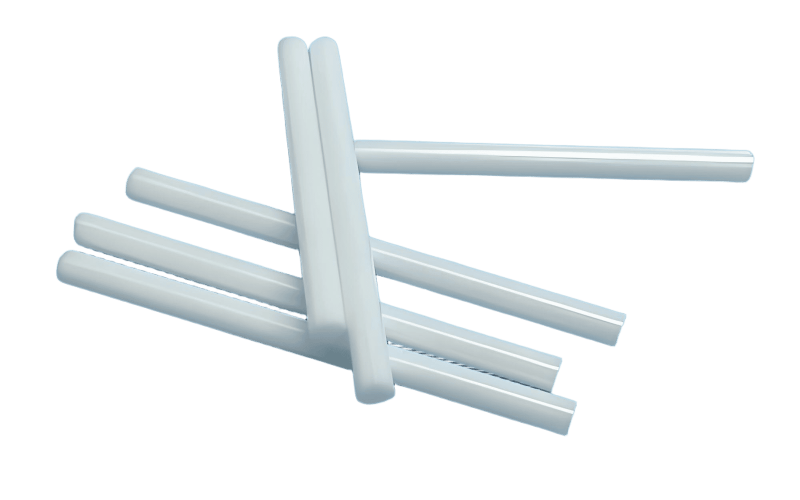Table of Contents
Hey, guess what? Zirconium dioxide, or zirconia, is a super cool material, and its market is growing fast! In 2023, it was worth $5.2 billion, and by 2025, it’s set to hit $5.9 billion. That’s because it’s super tough and used in tons of cool stuff like teeth and cars. Check out this table to see how big it’s getting!
| Year | Market Size (USD Billion) |
|---|---|
| 2023 | 5.2 |
| 2025 | 5.9 |
| 2030 | 8.6 |
Why Zirconia Rocks
Zirconium dioxide is a white, strong ceramic that’s tougher than most materials. It’s awesome for things like dental crowns, electronics, and even car engines. Plus, it’s way harder and safer for your body than other stuff like alumina. At Eshino Precision, we love using it to make amazing parts!
So, let’s dive in and see why zirconium dioxide is such a big deal!
What Is Zirconium Dioxide?
The Basics of Zirconia
Zirconium dioxide, or zirconia, is a strong, white ceramic called ZrO₂. It’s found in nature as a mineral called baddeleyite, or we can make it in labs. Think of it as a super-tough material that doesn’t crack under pressure or heat! It’s like the superhero of ceramics, perfect for hard jobs.
We use it at Eshino Precision for things like zirconia ceramic rods. It’s tough and lasts a long time!
How It Changes
Zirconia can change its shape a bit depending on how hot it gets. Below 1170°C, it’s one shape called monoclinic. Then, it switches to tetragonal up to 2370°C, and above that, it’s cubic. To keep it strong and stop it from breaking, we add special stuff like yttrium oxide. This makes it super reliable for mechanical engineering!
Why It’s Cool
Because zirconium dioxide is so tough, it’s great for lots of things. It can handle heat up to 2680°C—that’s hotter than lava! Plus, it doesn’t react with chemicals, so it stays strong. “Zirconia is a game-changer for tough jobs,” says Dr. Sarah Kim, a ceramics expert at TechMaterials Inc. Want to know more about ceramics? Check out what structural ceramics are!
Why Zirconia Stands Out
Super Hard Stuff
Zirconium dioxide is crazy hard—almost as tough as a diamond! This makes it awesome for tools that cut or grind, like ceramic cutting tools. It doesn’t wear out fast, so it’s perfect for big jobs. Learn more about its toughness at high hardness!
Heat? No Problem!
Zirconia can take heat up to 2680°C without melting. That’s why it’s great for hot places like furnaces or car engines. It keeps things safe and working. See how it handles heat at high-temperature resistance!
Body-Friendly and More
Here’s a cool list of why zirconium dioxide is special:
- Body-Safe: Perfect for dental crowns and implants—it’s gentle on you!
- Chemical-Proof: Doesn’t rust or break in tough chemicals.
- No Sparks: Great for electronics because it doesn’t conduct electricity.
It’s even used to make fake diamonds that sparkle like real ones! Check out its perks at zirconia benefits!
Where You’ll Find Zirconia in Action
Fixing Your Teeth
Zirconium dioxide is a star in dentistry! It’s used for dental crowns and implants because it’s strong and looks natural. It’s safe for your body and lasts a long time—way better than old materials like alumina. Want to know more? Visit medical applications!
Hot Furnaces
In big factories, zirconia lines furnaces that get super hot—up to thousands of degrees! It doesn’t melt or crack, so it’s perfect for chemical plants. Our zirconia ceramic tubes are awesome for this!
Cars and Tech
Cars use zirconium dioxide to coat engine parts, making them run better and last longer. It’s also in car sensors and electronics like oxygen sensors. From your phone to your car, zirconia’s everywhere!
Jewelry Fun
Ever heard of cubic zirconia? It’s a type of zirconium dioxide that looks like a diamond but costs way less. People love it for rings and necklaces because it shines bright and doesn’t scratch easily. It’s a fun way to use this tough stuff!

Zirconia Rod - Tough and Ready!

Zirconia Tube - Heat-Proof Power!
How Zirconia Is Made
Starting with Sand
Zirconium dioxide, or zirconia, starts as zircon sand. This sand has zirconium in it, and we dig it up from places like beaches. It’s the first step to making this tough stuff! Then, we clean it up to get ready for the big process. At Eshino Precision, we use top-notch sand for our zirconia ceramics!
Super Hot Magic
Next, we heat the sand in two cool ways. First, there’s the fused way—think of a giant oven hotter than 2600°C! It melts the sand into big chunks we can crush later. Or, we use chemicals like caustic soda to pull out pure zirconium dioxide. Both ways make it strong for tough jobs!
Shaping It Up
After that, we shape the zirconium dioxide into parts like rods or tubes. It’s like molding clay into a toy! We crush the chunks or press the powder into shapes, then bake it again to make it super hard. Check out our zirconia ceramic rods to see how it turns out!
Making It Perfect
Finally, we polish it so it’s smooth and shiny. This helps it work better in things like dental implants. “The process makes zirconia unbeatable,” says Dr. Sarah Kim from TechMaterials Inc. We do this at Eshino Precision to give you the best stuff!
Zirconia vs. Other Ceramics: The Showdown
Here’s the Fight
Let’s see how zirconium dioxide stacks up against other ceramics like alumina! Zirconia is tougher and better for lots of things. Check out this table to see why it wins:
| Feature | Zirconia | Alumina |
|---|---|---|
| Toughness | High | Medium |
| Heat Resistance | Excellent | Good |
| Body-Friendly | Top-Notch | Okay |
| Cost | Higher | Lower |
Why Zirconia Beats Alumina
Zirconium dioxide is tougher because it can change shape a little without breaking. That’s perfect for hard jobs! It also handles heat better than alumina, so it’s great for furnaces or engines. See the difference at zirconia vs. alumina!
When Alumina Works
Alumina is cheaper and fine for simple stuff like regular ceramics. But for big, tough things like car parts, zirconia is the champ. It lasts longer and stays strong!
Zirconia’s Growing Market
How Big It’s Getting
The market for zirconium dioxide is growing fast! In 2023, it was $5.2 billion. By 2025, it’s expected to hit $5.9 billion, and by 2030, it could reach $8.6 billion. That’s a jump of 6.5% every year! It’s because people love it for healthcare and tech.
Why It’s Booming
So, why is zirconium dioxide so hot right now? More people need it for nuclear power—about 90% of zirconium goes there! Plus, doctors use it for implants, and tech folks want it for sensors. Big companies like Rio Tinto and Saint-Gobain are making tons of it!
What’s Pushing It
Places like Asia are building more, so they need zirconia for furnaces and glazes. Some reports say the market is smaller, like $80 million, but that’s just for tiny bits. The big picture says billions, and we agree—it’s growing huge!
Your Zirconia Questions Answered
What’s It For?
People ask, “What’s zirconium dioxide used for?” Tons of stuff! It’s in dental crowns, furnace linings, car engines, fake diamonds, and sensors. It’s super strong and safe, so it’s everywhere!
Is It Safe?
Yes! Zirconium dioxide is awesome for your body. It’s used in implants and teeth because it’s tough and doesn’t hurt you. It’s way better than older stuff like alumina!
How’s It Made?
Another big question: “How do we make zirconia?” Easy—it starts with sand, gets melted or cleaned with chemicals, and then shaped into cool parts like tubes. Simple but powerful!
Better Than Alumina?
Yep, zirconium dioxide beats alumina for tough jobs. It’s stronger and lasts longer in heat or stress. Check out how zirconia lasts!
The Future of Zirconia
Tiny Tech Wonders
Zirconium dioxide is going small! Soon, we’ll use tiny bits of zirconia, called nanoparticles, in cool stuff like paints and electronics. These little pieces make things stronger and shinier. Imagine your phone screen lasting longer—that’s the future of zirconia! It’s growing big in the coatings world too.
Helping Doctors More
In the future, zirconium dioxide will do even more for doctors. It’s already awesome for dental crowns, but soon it might help deliver medicine or coat tools inside your body. It’s safe and strong, so it’s perfect for new health tricks. We’re excited at Eshino Precision to see this happen!
Green Power Ahead
Zirconia is also jumping into green energy! It’s used in special fuel cells that make clean power with no pollution. These cells need zirconium dioxide because it handles heat and moves energy well. Check out how it fits in new energy. Plus, we’re making it in greener ways to help the planet!
Why Choose Zirconia with Eshino Precision?
It’s a Super Star
Zirconium dioxide is amazing! It’s super tough, works in crazy heat, and is safe for your body. From zirconia rods to fake diamonds, it’s everywhere—dentistry, cars, tech, and more. “Zirconia’s future is bright and strong,” says Dr. Sarah Kim from TechMaterials Inc. We agree—it’s a powerhouse!
Why We’re the Best
At Eshino Precision, we make top-quality zirconium dioxide parts. Whether you need tubes for furnaces or implants for teeth, we’ve got you covered. Our stuff lasts long and works great, saving you time and money. See how we help at maintenance costs!
More to Explore
Want to learn more? Here are some great places to check out:
Ready to Transform Your Engineering Solutions?
No industrial challenge is too complex for Eshino. From precision ceramic rods and advanced bushings to customized nozzles and other high-performance components, we engineer solutions that combine exceptional durability, thermal resistance, and precision to meet your specific needs. Whatever your industry demands, Eshino delivers tailored expertise you can trust.

